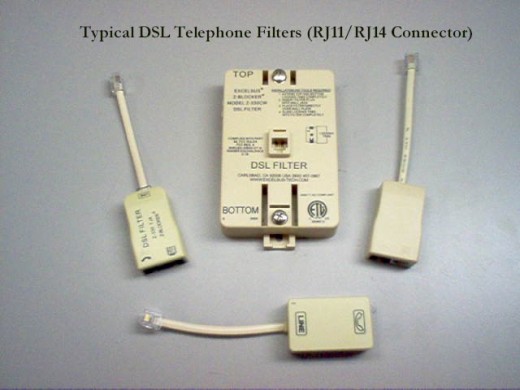Step-by-Step Guide for troubleshooting DSL connection issues.
Ok, so we've all been there. We have our high speed DSL internet connection and we need to check our email. So we sit down at the computer and pull up our browser, only to find that our connection to the World Wide Web is not functioning. We close the window and try again, maybe check to make sure everything is plugged in correctly and we still can't seem to make it work. So now we're frustrated and we have to resort to calling in to the technical support line.
Well, with DSL, there are a lot of things you can try before you call in that may very well resolve your problem without you ever having to call. I'll go into these now...
- Powercycle your modem (and router if you are using one) by unplugging the power cord (if you happen to have an on/off switch leave it to on and unplug the cord) for 30 seconds. Plug them back in and wait for them to fully power up (as indicated by the lights on the display which will vary depending upon the brand of modem you have). If you are using a router, plug the modem in FIRST, waiting for it to power on fully and THEN plug in the router. I know all that may seem basic, but trust me... this can solve a lot of problems.
- If after powercycling, you are still unable to get online, check all wire connections both to the modem and to your computer. It doesn't take the wire being loose by much for the connection to fail.
- If you share the dsl with your normal telephone line (which is the case is most situations) make sure that every analog device (i.e,- telephone, fax machine, if you have a dial up modem plugged in as well, etc.) has an inline filter attached to it. These come with your installation package and should be labeled as such. The filters have a small telephone wire that plugs into the jack with another telephone jack at the other end. Usually they are gray or white/off-white in color, rectangular and about 2 inches long. Plug the phone, fax or whatever device into the jack on the filter. Make sure this filter is NOT on the phone line going to the modem. The purpose of this filter is to filter out the DSL signal and prevent it from "leaking" into the other devices on that line. This is a big problem.

4. If after checking all of that, you are still not online, unplug any device that shares the dsl line from the wall jack(s) leaving only the modem connected to the phone line. This will let you know if perhaps you just have a bad filter. If after doing this your internet is back up, plug your other devices in one at a time to determine which filter will need to be replaced (most of the time you can order them through your service provider or pick them up at a local electronics store).
5. You have now checked all those things and still can't get online. Its time to turn to the computer, and the following steps assume someone is using internet explorer on a windows based operating system. In internet explorer, click on tools, then internet options. Depending on your version of Internet Explorer you will see under the General tab the category "Browsing History" with a delete button under it, or you will see a button that says "Delete Files". In the first instance, click the delete button, in the list that pops up click the first line is "Temporary Internet Files", click the button to delete. In the second instance, click the "Delete Files" button and then put a checkmark in the "Delete all offline content" box and click ok. Now try to browse.
6. If that doesn't work, the final step is to check your computers IP address. Again assuming you are using a windows system, click Start, then Run. In the Run box that appears type "cmd" (short for command). If you are using Windows Vista and have not changed the Start menu view, right above the start button is a box saying "Search Programs", type "cmd" into this box. Above that at the top you will see a small icon with the letters "cmd" next to it. RIGHT click this, and select "Run as administrator" from the list that appears. Now we have a black box with the blinking cursor (the DOS prompt), and it does not matter what is already in there before the cursor, it doesn't affect what we will be doing. Type there "ipconfig /release" It will bring up a list of things, what we are looking for is the IP address (in Vista it will be the IPv4 address). This should now be blank or all zeroes. Now type "ipconfig /renew". Now next to where your IP address is there should be a number. Now IP addresses vary by ISP and obviously individual so I can't tell you what it will be, but there are some things to look for. If you have a router, typicall your IP address will start with "192.x.x.x" (X's are added simply as place holders for illustration). What you don't want to see is an IP of "169.x.x.x" or obviously you don't want this to time out or again come back blank of with all zeroes. If performing this gave you good IP address, then check your connection online.
If still nothing, then it may now be time to call your ISP's tech support line... but remember a few things when you do call...
First- The person you are talking to is not responsible for the problem, they are the ones trying to help you get it fixed. Screaming and cursing at them does nothing but waste time that could be used getting you back up and running. I know we get angry with this happens, especially if its an internet account used for a business, but try to keep it to a minimum. The more cooperative you are with the rep you're on the phone with then the faster the call will go and the more likely they will go above and beyond in assisting you.
Second- Not every problem requires a technician to be sent out to your house/business. 90-95% of connection issues can and are resolved during the call and are more to do with basic setup or issues on the pc or browser. The steps they ask you to take ARE important (and have mostly outlined above). Resolving the problem is all about eliminating possible causes until you arrive at the issue. If you demand a technician and on the very unlikely chance they agree to send one without troubleshooting, there is a very good chance you will be out of service longer. The technicians that go out only service the lines and do not and are not trained to check the setup in the computer or the setup of the modem, that's what the phone representative is for.
I hope this has given you some help in this area and prevents further hair-pulling sessions in the future.









